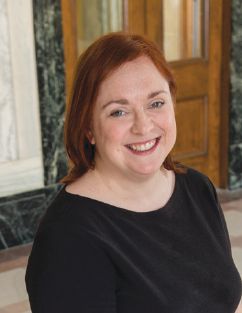Change Leader: Engineering Is Much More Than What’s Taught in School

These profiles are based on interviews, and the opinions and statements are those of the subject and are not necessarily shared or endorsed by this publication.
After many years as a student and teacher of engineering, Mac Namara has seen firsthand which teaching techniques work best and which need to be improved. In engineering, students often are taught that there’s a “correct answer” that focuses on solutions that are more or less the same. Her teaching and research—as well as the book she co-authored—convinced her that engineering students need a broader education to better prepare them for their careers so they can help make the best designs for clients.
“Any career has a component of lifelong learning, and a big facet for civil and structural engineers is figuring out how to work with nontechnical experts, nontechnical stakeholders in any project they’re doing,” says Mac Namara.
Relationships Lead to Collaboration
For her book, she interviewed many engineers and architects and found that although their educations didn’t always include a lot of intermixing, the most successful professionals learned quickly that they needed to collaborate with each other and learn each other’s “language.”
“Working with others to bring in expertise that you don’t have is an incredibly important skill,” she notes.
Civil engineers are best served when they understand designers’ project goals and how they bring a very different expertise. She also notes that the best design teams share a common vocabulary, and civil and structural engineers who work in the field for any length learn architects’ techniques and design languages. Students don’t always graduate with this knowledge, but she’s hoping that will steadily change.
“Engineering students need to get a bit more engaged in design, in talking about design and learning about design,” she notes. Their careers require lifelong learning that will happen over time, and they need to “open the windows” for that.
Lessons Learned
In researching her book, Mac Namara found a few key characteristics shared by the world’s best architects and engineers.
“People who do this work well have a tremendous amount of respect for each other’s expertise and often formed lifelong working relationships,” she adds. “We found that engineering firms may have an individual architect or two they’ve worked with for years, even if that individual person worked at different firms over that time.”
Through time, mutual trust builds up as well as respect for each other’s expertise. Where those relationships were good, engineers often had more influence on the design than most architecture students would imagine.
“Architects who have been in the field for years know this and have these good working relationships,” says Mac Namara. “But students of architecture tend to think they’re the sole author of the objects, and students of civil engineering don’t tend to know much about design at all.”
Learn Visual Techniques and Study History
Another key recommendation Mac Namara has for engineering students entering the workforce is engagement with “visualization and representation” techniques and technologies. Engineers often aren’t explicitly taught to use the tools of drawing and communication, including everything from BIM models to hand sketches to 3D virtual-reality programs. She also believes engineering education can focus too much on “correct” or “singular” answers to problems.
“The reality is that the vast majority of engineering solutions are contextual; they’re neither unique nor universal,” explains Mac Namara. “There isn’t one answer to most engineering problems. There are a range of answers that work, and we don’t tend to teach engineering students to really appreciate that and be willing to engage in the iterative process of going into a meeting, throwing out six or seven ideas, and seeing which one works.”
She notes that architects work with clients to solve many problems: how people move around the building, what the building looks like, how the building performs thermally and how the building performs environmentally. Such a complex set of needs sometimes conflicts with the basic needs and technical constraints that come from structural engineers. Therefore, structural engineers need to hear about the architects’ goals, and engage with drawings, sketches, models and other visual techniques to help understand those competing goals for the design.
“The other big thing we came across was engineering students don’t know the history of engineering that well,” notes Mac Namara. “You wouldn’t dream of graduating somebody from the school of architecture without taking history of architecture classes. Yet nobody is surprised that civil or structural engineering students don’t have the same education. They don’t know about Gustave Eiffel, or they don’t necessarily know how the different materials came into the profession and what influence they had.”
About Todd Danielson
Todd Danielson has been in trade technology media for more than 20 years, now the editorial director for V1 Media and all of its publications: Informed Infrastructure, Earth Imaging Journal, Sensors & Systems, Asian Surveying & Mapping, and the video news portal GeoSpatial Stream.


